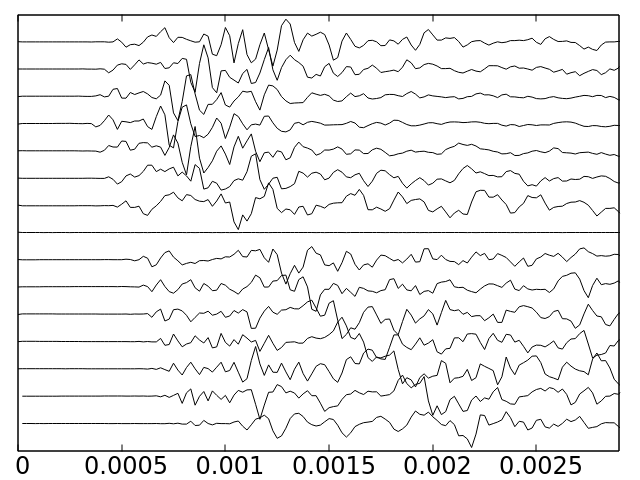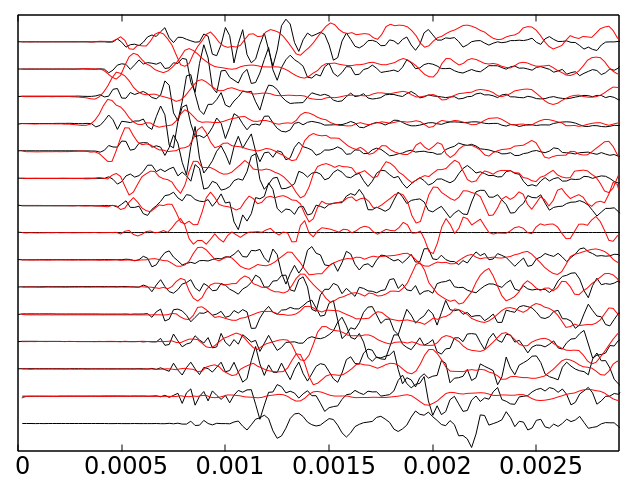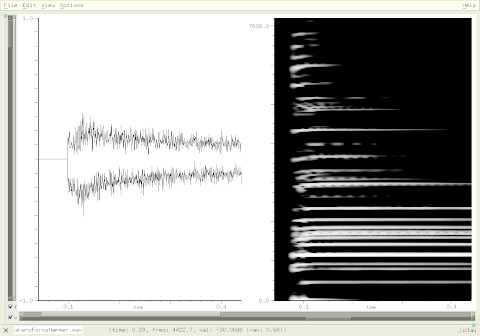...loading...
Navigate this deck with keyboard or touch
type "m" for the menu of pages and
arrow or page keys to advance or rewind
two-finger tap for the menu of pages and
the usual left/right swipe to advance or rewind
embedded media clips (audio and video) use an extra click (or swipe) to begin playing
and another to finish
type "m" for the menu of pages and
arrow or page keys to advance or rewind
two-finger tap for the menu of pages and
the usual left/right swipe to advance or rewind
 Extensions to the 2D Waveguide Mesh for Modeling Thin Plate Vibrations
Extensions to the 2D Waveguide Mesh for Modeling Thin Plate Vibrations
Chris Chafe
Center for Computer Research in Music and Acoustics
(CCRMA)
Stanford University
The 2D Waveguide Mesh computes realistic-sounding simulations of struck plates. The early 90’s saw an initial flurry of development on the model but it hasn’t yet found the greater musical use that its interesting sonic qualities suggest are possible.
The overall project goal is a synthesis instrument for real-time music performance and studio composition.
The overall project goal is a synthesis instrument for real-time music performance and studio composition.
 Rectilinear mesh using 4-port scattering junctions and unit delays (Julius Smith)
Rectilinear mesh using 4-port scattering junctions and unit delays (Julius Smith)
 Adding edge filters and reflections, Synthesis Toolkit (12x12 nodes)
Adding edge filters and reflections, Synthesis Toolkit (12x12 nodes)
 Enhancements which will be described (32x8 nodes)
Enhancements which will be described (32x8 nodes)
 Swinging in space simulated by wavefield synthesis
Swinging in space simulated by wavefield synthesis
Synthesis Toolkit's Mesh2D class - The C++ implementation has been ported to many computer music languages (ChucK, SuperCollider, Csound, etc.)
- Mesh size originally limited to 12x12 (probably for historical reasons related to limited CPU)
- One input (dynamically adjustable location but non-interpolated ie., quantized to an integer X/Y coordinate position)
- One output (upper right corner)
Synthesis Toolkit's Mesh2D class - The C++ implementation has been ported to many computer music languages (ChucK, SuperCollider, Csound, etc.)
- Mesh size originally limited to 12x12 (probably for historical reasons related to limited CPU)
- One input (dynamically adjustable location but non-interpolated ie., quantized to an integer X/Y coordinate position)
- One output (upper right corner)
Excitation noteOn
method adds a single sample impulse to the input node (with adjustable amplitude) inputTick
method adds an external signal to the input node
Excitation noteOn
method adds a single sample impulse to the input node (with adjustable amplitude) inputTick
method adds an external signal to the input node
noteOnmethod adds a single sample impulse to the input node (with adjustable amplitude)
inputTickmethod adds an external signal to the input node

noteOn
(32x8 nodes)
noteOn
(32x8 nodes)
noteOn(32x8 nodes)

inputTick
External excitation signal from synthesized stikes (impulsed filters in this example)
inputTick
External excitation signal from synthesized stikes (impulsed filters in this example)
inputTickExternal excitation signal from synthesized stikes (impulsed filters in this example)
 Brass plate in front of 15-channel microphone array
Brass plate in front of 15-channel microphone array
 Laser doppler vibrometer
Laser doppler vibrometer
 15-channel microphone array, 3 msec (channel 8 muted)
15-channel microphone array, 3 msec (channel 8 muted)
 Laser doppler vibrometer
Laser doppler vibrometer
 overlay of mic and LDV
overlay of mic and LDV
 speed of sound in brass plate and in air
speed of sound in brass plate and in air
 Testing 15-channel microphone array with an impulse generator
Testing 15-channel microphone array with an impulse generator
 Impulse response across mic (channel 8 muted)
Impulse response across mic (channel 8 muted)
 Channels independently normalized (speed of sound in air visible)
Channels independently normalized (speed of sound in air visible)
 Same thing for 15-channel wavefield synthesis (impulse response across array outputs)
Same thing for 15-channel wavefield synthesis (impulse response across array outputs)
 Channels independently normalized (speed of sound in air visible)
Channels independently normalized (speed of sound in air visible)
 Impulse response of mesh with 12 output taps
Impulse response of mesh with 12 output taps
 Mesh output (12 channels) fed through WFS array (15 outputs)
Mesh output (12 channels) fed through WFS array (15 outputs)
 Excitation (force hammer recording) added through WFS array
Excitation (force hammer recording) added through WFS array
 Creates the two wavefronts
Creates the two wavefronts
 Allpass filters for mode shifting and stretching "A Simplified Approach to Modeling Dispersion Caused by Stiffness in Strings and Plates," Scott Van Duyne and Julius Smith, 1994
Allpass filters for mode shifting and stretching "A Simplified Approach to Modeling Dispersion Caused by Stiffness in Strings and Plates," Scott Van Duyne and Julius Smith, 1994
 no allpass, only lowpass
no allpass, only lowpass
 allpass (order 4) with stretch factor = 0
allpass (order 4) with stretch factor = 0
 stretch factor = 0.73
stretch factor = 0.73
 signal dependent, passive nonlinearity "A Passive Nonlinear Digital Filter Design Which Facilitates Physics-based Sound Synthesis of Highly Nonlinear Musical Instruments," John Pierce and Scott Van Duyne, 1997
signal dependent, passive nonlinearity "A Passive Nonlinear Digital Filter Design Which Facilitates Physics-based Sound Synthesis of Highly Nonlinear Musical Instruments," John Pierce and Scott Van Duyne, 1997
 signal dependent stretch factor (pie pan)
signal dependent stretch factor (pie pan)
 Thanks for listening!
Thanks for listening!